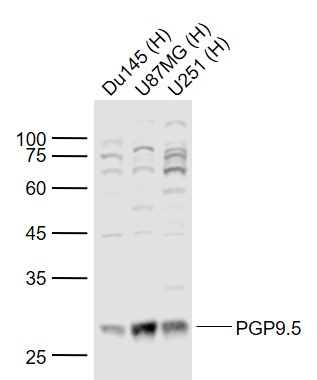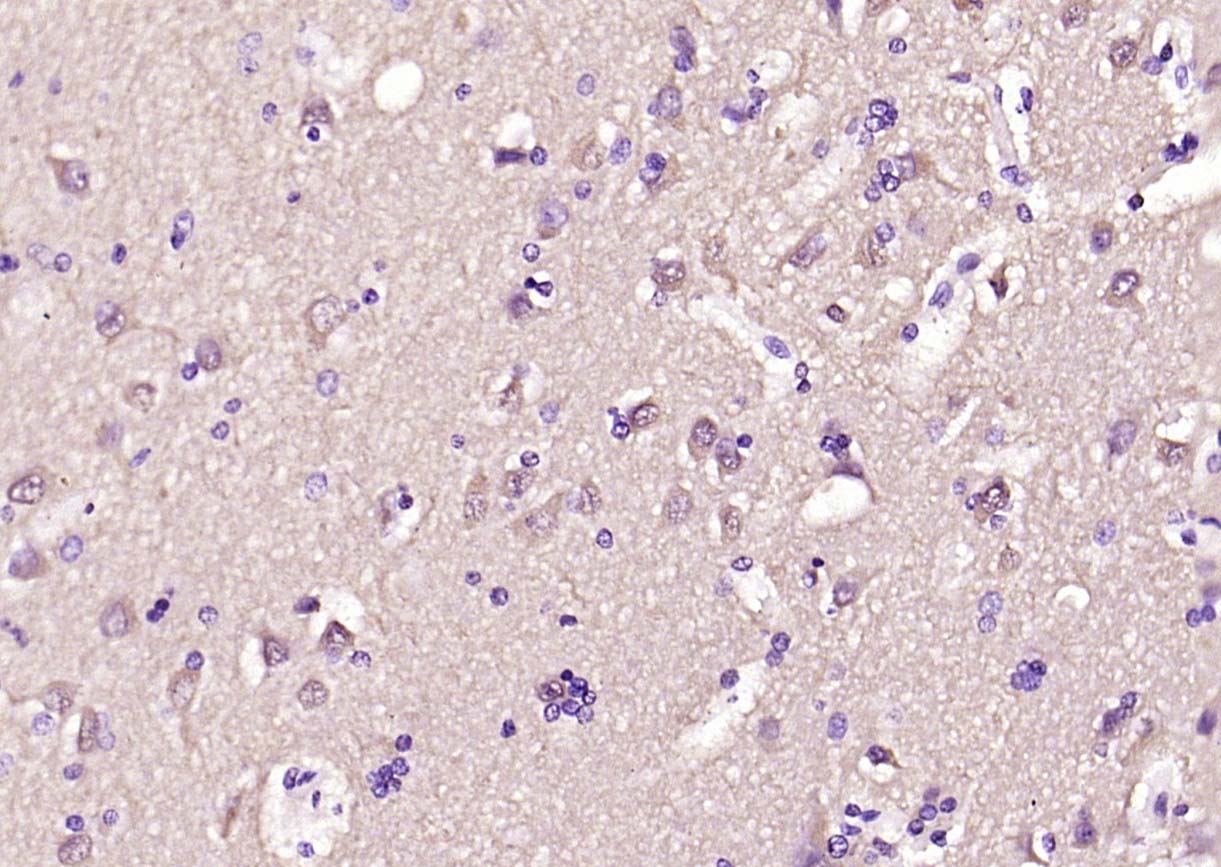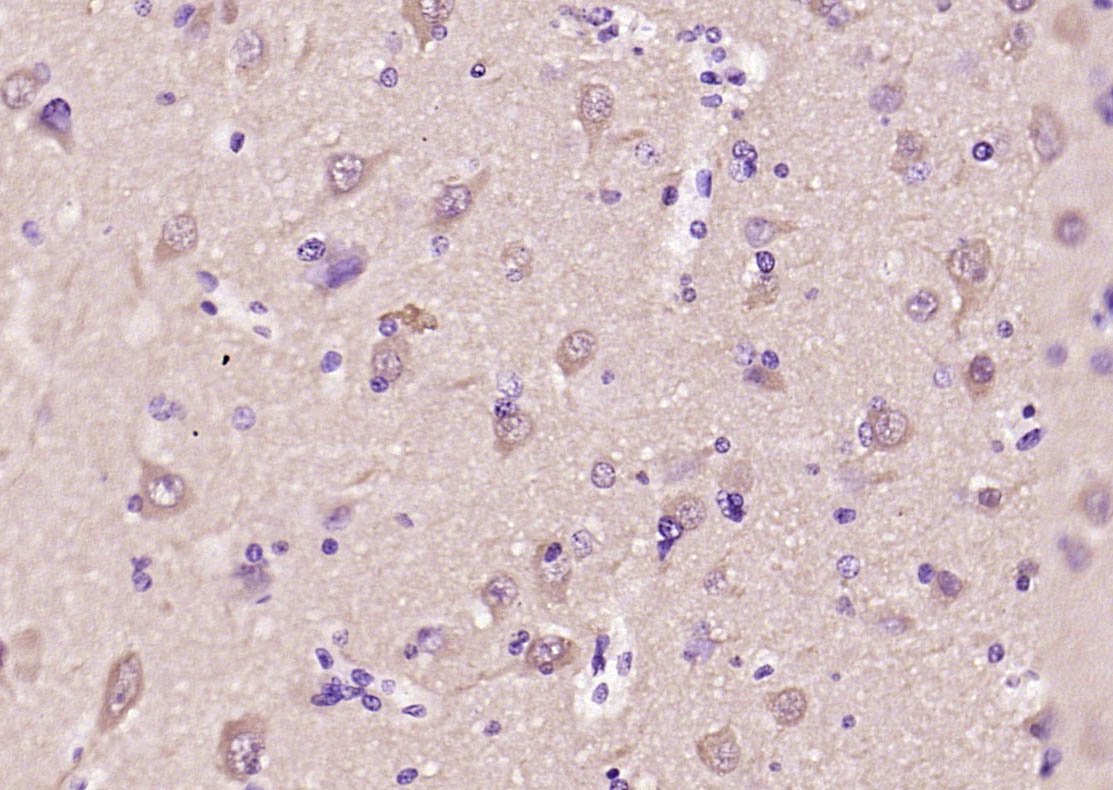
Rabbit Anti-PGP9.5 antibody
Gracile axonal dystrophy; Neuron cytoplasmic protein 9.5; Park 5; Park5; Parkinson Disease 5; PGP 9.5; PGP9.5; PGP95; Protein gene product 9.5; Ubiquitin C terminal esterase L1; Ubiquitin C terminal hydrolase (neuron specific); Ubiquitin C terminal hydrol
View History [Clear]
Details
Product Name PGP9.5 Chinese Name 神经细胞胞浆蛋白9.5/蛋白基因产物9.5抗体 Alias Gracile axonal dystrophy; Neuron cytoplasmic protein 9.5; Park 5; Park5; Parkinson Disease 5; PGP 9.5; PGP9.5; PGP95; Protein gene product 9.5; Ubiquitin C terminal esterase L1; Ubiquitin C terminal hydrolase (neuron specific); Ubiquitin C terminal hydrolase; Ubiquitin carboxyl terminal esterase L1; Ubiquitin carboxyl terminal hydrolase isozyme L1; Ubiquitin carboxyl-terminal hydrolase isozyme L1; Ubiquitin thioesterase L1; Ubiquitin thiolesterase; Ubiquitin thiolesterase L1; UCH L1; UCH-L1; UCHL1; UCHL1_HUMAN. Research Area Cell biology Neurobiology Cell type markers Ubiquitin Immunogen Species Rabbit Clonality Polyclonal React Species Human, Applications WB=1:500-2000 IHC-P=1:400-800 (Paraffin sections need antigen repair)
not yet tested in other applications.
optimal dilutions/concentrations should be determined by the end user.Theoretical molecular weight 25kDa Cellular localization cytoplasmic The cell membrane Form Lyophilized or Liquid Concentration 1mg/ml immunogen Recombinant human UCHL1 Lsotype IgG Purification affinity purified by Protein A Buffer Solution 0.01M TBS(pH7.4) with 1% BSA, 0.03% Proclin300 and 50% Glycerol. Storage Store at -20 °C for one year. Avoid repeated freeze/thaw cycles. The lyophilized antibody is stable at room temperature for at least one month and for greater than a year when kept at -20°C. When reconstituted in sterile pH 7.4 0.01M PBS or diluent of antibody the antibody is stable for at least two weeks at 2-4 °C. Attention This product as supplied is intended for research use only, not for use in human, therapeutic or diagnostic applications. PubMed PubMed Product Detail The protein encoded by this gene belongs to the peptidase C12 family. This enzyme is a thiol protease that hydrolyzes a peptide bond at the C-terminal glycine of ubiquitin. This gene is specifically expressed in the neurons and in cells of the diffuse neuroendocrine system. Mutations in this gene may be associated with Parkinson disease.[provided by RefSeq, Sep 2009]
Function:
Ubiquitin-protein hydrolase involved both in the processing of ubiquitin precursors and of ubiquitinated proteins. This enzyme is a thiol protease that recognizes and hydrolyzes a peptide bond at the C-terminal glycine of ubiquitin. Also binds to free monoubiquitin and may prevent its degradation in lysosomes. The homodimer may have ATP-independent ubiquitin ligase activity.
Subcellular Location:
Cytoplasm. Endoplasmic reticulum membrane. About 30% of total UCHL1 is associated with membranes in brain.
Tissue Specificity:
Found in neuronal cell bodies and processes throughout the neocortex (at protein level). Expressed in neurons and cells of the diffuse neuroendocrine system and their tumors. Weakly expressed in ovary. Down-regulated in brains from Parkinson disease and Alzheimer disease patients.
Post-translational modifications:
O-glycosylated.
DISEASE:
Defects in UCHL1 are the cause of Parkinson disease type 5 (PARK5) [MIM:613643]; also known as Parkinson disease autosomal dominant 5. PARK5 is a complex neurodegenerative disorder with manifestations ranging from typical Parkinson disease to dementia with Lewy bodies. Clinical features include parkinsonian symptoms (resting tremor, rigidity, postural instability and bradykinesia), dementia, diffuse Lewy body pathology, autonomic dysfunction, hallucinations and paranoia.
Similarity:
Belongs to the peptidase C12 family.
SWISS:
P09936
Gene ID:
7345
Database links:Entrez Gene: 7345 Human
Entrez Gene: 22223 Mouse
Entrez Gene: 101117250 Sheep
Entrez Gene: 325119 Zebrafish
Omim: 191342 Human
SwissProt: P09936 Human
SwissProt: Q9R0P9 Mouse
Unigene: 518731 Human
Unigene: 29807 Mouse
Unigene: 107213 Rat
Product Picture
Lane 1: Du145 (Human) Cell Lysate at 30 ug
Lane 2: U87MG (Human) Cell Lysate at 30 ug
Lane 3: U251 (Human) Cell Lysate at 30 ug
Primary:
Anti-PGP9.5 (SL41257R) at 1/1000 dilution
Secondary: IRDye800CW Goat Anti-Rabbit IgG at 1/20000 dilution
Predicted band size: 29/26 kD
Observed band size: 29 kD
Paraformaldehyde-fixed, paraffin embedded (human brain); Antigen retrieval by boiling in sodium citrate buffer (pH6.0) for 15min; Block endogenous peroxidase by 3% hydrogen peroxide for 20 minutes; Blocking buffer (normal goat serum) at 37°C for 30min; Antibody incubation with (PGP9.5) Polyclonal Antibody, Unconjugated (SL41257R) at 1:200 overnight at 4°C, followed by operating according to SP Kit(Rabbit) (sp-0023) instructionsand DAB staining.Paraformaldehyde-fixed, paraffin embedded (human brain); Antigen retrieval by boiling in sodium citrate buffer (pH6.0) for 15min; Block endogenous peroxidase by 3% hydrogen peroxide for 20 minutes; Blocking buffer (normal goat serum) at 37°C for 30min; Antibody incubation with (PGP9.5) Polyclonal Antibody, Unconjugated (SL41257R) at 1:200 overnight at 4°C, followed by operating according to SP Kit(Rabbit) (sp-0023) instructionsand DAB staining.
References (0)
No References
Bought notes(bought amounts latest0)
No one bought this product
User Comment(Total0User Comment Num)
- No comment





 +86 571 56623320
+86 571 56623320
 +86 18668110335
+86 18668110335

